
Warmup: Design a CFG to generate the language \(\{a^i b^j \mid j \geq i \geq 0\}\)
Sample derivation:
Design a PDA to recognize the language \(\{a^i b^j \mid j \geq i \geq 0\}\)
Theorem 2.20: A language is generated by some context-free grammar if and only if it is recognized by some push-down automaton.
Definition: a language is called context-free if it is the language generated by a context-free grammar. The class of all context-free language over a given alphabet \(\Sigma\) is called CFL.
Consequences:
Quick proof that every regular language is context free
To prove closure of the class of context-free languages under a given operation, we can choose either of two modes of proof (via CFGs or PDAs) depending on which is easier
To fully specify a PDA we could give its \(6\)-tuple formal definition or we could give its input alphabet, stack alphabet, and state diagram. An informal description of a PDA is a step-by-step description of how its computations would process input strings; the reader should be able to reconstruct the state diagram or formal definition precisely from such a descripton. The informal description of a PDA can refer to some common modules or subroutines that are computable by PDAs:
PDAs can “test for emptiness of stack” without providing details. How? We can always push a special end-of-stack symbol, \(\$\), at the start, before processing any input, and then use this symbol as a flag.
PDAs can “test for end of input” without providing details. How? We can transform a PDA to one where accepting states are only those reachable when there are no more input symbols.
Suppose \(L_1\) and \(L_2\) are context-free languages over \(\Sigma\). Goal: \(L_1 \cup L_2\) is also context-free.
Approach 1: with PDAs
Let \(M_1 = ( Q_1, \Sigma, \Gamma_1, \delta_1, q_1, F_1)\) and \(M_2 = ( Q_2, \Sigma, \Gamma_2, \delta_2, q_2, F_2)\) be PDAs with \(L(M_1) = L_1\) and \(L(M_2) = L_2\).
Define \(M =\)
Approach 2: with CFGs
Let \(G_1 = (V_1, \Sigma, R_1, S_1)\) and \(G_2 = (V_2, \Sigma, R_2, S_2)\) be CFGs with \(L(G_1) = L_1\) and \(L(G_2) = L_2\).
Define \(G =\)
Suppose \(L_1\) and \(L_2\) are context-free languages over \(\Sigma\). Goal: \(L_1 \circ L_2\) is also context-free.
Approach 1: with PDAs
Let \(M_1 = ( Q_1, \Sigma, \Gamma_1, \delta_1, q_1, F_1)\) and \(M_2 = ( Q_2, \Sigma, \Gamma_2, \delta_2, q_2, F_2)\) be PDAs with \(L(M_1) = L_1\) and \(L(M_2) = L_2\).
Define \(M =\)
Approach 2: with CFGs
Let \(G_1 = (V_1, \Sigma, R_1, S_1)\) and \(G_2 = (V_2, \Sigma, R_2, S_2)\) be CFGs with \(L(G_1) = L_1\) and \(L(G_2) = L_2\).
Define \(G =\)
Summary
Over a fixed alphabet \(\Sigma\), a language \(L\) is regular
iff it is described by some regular expression
iff it is recognized by some DFA
iff it is recognized by some NFA
Over a fixed alphabet \(\Sigma\), a language \(L\) is context-free
iff it is generated by some CFG
iff it is recognized by some PDA
Fact: Every regular language is a context-free language.
Fact: There are context-free languages that are not nonregular.
Fact: There are countably many regular languages.
Fact: There are countably inifnitely many context-free languages.
Consequence: Most languages are not context-free!
Examples of non-context-free languages
\[\begin{aligned} &\{ a^n b^n c^n \mid 0 \leq n , n \in \mathbb{Z}\}\\ &\{ a^i b^j c^k \mid 0 \leq i \leq j \leq k , i \in \mathbb{Z}, j \in \mathbb{Z}, k \in \mathbb{Z}\}\\ &\{ ww \mid w \in \{0,1\}^* \} \end{aligned}\] (Sipser Ex 2.36, Ex 2.37, 2.38)
There is a Pumping Lemma for CFL that can be used to prove a specific language is non-context-free: If \(A\) is a context-free language, there there is a number \(p\) where, if \(s\) is any string in \(A\) of length at least \(p\), then \(s\) may be divided into five pieces \(s = uvxyz\) where (1) for each \(i \geq 0\), \(uv^ixy^iz \in A\), (2) \(|uv|>0\), (3) \(|vxy| \leq p\). We will not go into the details of the proof or application of Pumping Lemma for CFLs this quarter.
Regular sets are not the end of the story
Many nice / simple / important sets are not regular
Limitation of the finite-state automaton model: Can’t “count", Can only remember finitely far into the past, Can’t backtrack, Must make decisions in “real-time"
We know actual computers are more powerful than this model...
The next model of computation. Idea: allow some memory of unbounded size. How?
To generalize regular expressions: context-free
grammars
To generalize NFA: Pushdown automata, which is like an NFA with access to a stack: Number of states is fixed, number of entries in stack is unbounded. At each step (1) Transition to new state based on current state, letter read, and top letter of stack, then (2) (Possibly) push or pop a letter to (or from) top of stack. Accept a string iff there is some sequence of states and some sequence of stack contents which helps the PDA processes the entire input string and ends in an accepting state.
Is there a PDA that recognizes the nonregular language \(\{0^n1^n \mid n \geq 0 \}\)?

The PDA with state diagram above can be informally described as:
Read symbols from the input. As each 0 is read, push it onto the stack. As soon as 1s are seen, pop a 0 off the stack for each 1 read. If the stack becomes empty and we are at the end of the input string, accept the input. If the stack becomes empty and there are 1s left to read, or if 1s are finished while the stack still contains 0s, or if any 0s appear in the string following 1s, reject the input.
Trace the computation of this PDA on the input string \(01\).
Trace the computation of this PDA on the input string \(011\).
A PDA recognizing the set \(\{ \hspace{1.5 in} \}\) can be informally described as:
Read symbols from the input. As each 0 is read, push it onto the stack. As soon as 1s are seen, pop a 0 off the stack for each 1 read. If the stack becomes empty and there is exactly one 1 left to read, read that 1 and accept the input. If the stack becomes empty and there are either zero or more than one 1s left to read, or if the 1s are finished while the stack still contains 0s, or if any 0s appear in the input following 1s, reject the input.
Modify the state diagram below to get a PDA that implements this description:

Definition A pushdown automaton (PDA) is specified by a \(6\)-tuple \((Q, \Sigma, \Gamma, \delta, q_0, F)\) where \(Q\) is the finite set of states, \(\Sigma\) is the input alphabet, \(\Gamma\) is the stack alphabet, \[\delta: Q \times \Sigma_\varepsilon \times \Gamma_\varepsilon \to \mathcal{P}( Q \times \Gamma_\varepsilon)\] is the transition function, \(q_0 \in Q\) is the start state, \(F \subseteq Q\) is the set of accept states.
Draw the state diagram and give the formal definition of a PDA with \(\Sigma = \Gamma\).
Draw the state diagram and give the formal definition of a PDA with \(\Sigma \cap \Gamma = \emptyset\).
For the PDA state diagrams below, \(\Sigma = \{0,1\}\).
| Mathematical description of language | State diagram of PDA recognizing language |
|---|---|
| \(\Gamma = \{ \$, \#\}\) | |
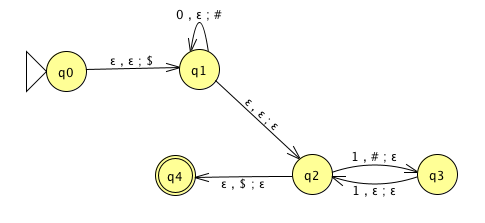 |
|
| \(\Gamma = \{ {@}, 1\}\) | |
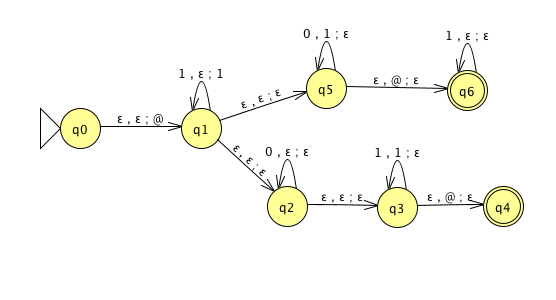 |
|
| \(\{ 0^i 1^j 0^k \mid i,j,k \geq 0 \}\) | |
Note: alternate notation is to replace \(;\) with \(\to\)
Big picture: PDAs were motivated by wanting to add some memory of unbounded size to NFA. How do we accomplish a similar enhancement of regular expressions to get a syntactic model that is more expressive?
DFA, NFA, PDA: Machines process one input string at a time; the computation of a machine on its input string reads the input from left to right.
Regular expressions: Syntactic descriptions of all strings that match a particular pattern; the language described by a regular expression is built up recursively according to the expression’s syntax
Context-free grammars: Rules to produce one string at a time, adding characters from the middle, beginning, or end of the final string as the derivation proceeds.
We are ready to introduce a formal model that will capture a notion of general purpose computation.
Similar to DFA, NFA, PDA: input will be an arbitrary string over a fixed alphabet.
Different from NFA, PDA: machine is deterministic.
Different from DFA, NFA, PDA: read-write head can move both to the left and to the right, and can extend to the right past the original input.
Similar to DFA, NFA, PDA: transition function drives computation one step at a time by moving within a finite set of states, always starting at designated start state.
Different from DFA, NFA, PDA: the special states for rejecting and accepting take effect immediately.
(See more details: Sipser p. 166)
Formally: a Turing machine is \(M= (Q, \Sigma, \Gamma, \delta, q_0, q_{accept}, q_{reject})\) where \(\delta\) is the transition function \[\delta: Q\times \Gamma \to Q \times \Gamma \times \{L, R\}\] The computation of \(M\) on a string \(w\) over \(\Sigma\) is:
Read/write head starts at leftmost position on tape.
Input string is written on \(|w|\)-many leftmost cells of tape, rest of the tape cells have the blank symbol. Tape alphabet is \(\Gamma\) with \(\textvisiblespace\in \Gamma\) and \(\Sigma \subseteq \Gamma\). The blank symbol \(\textvisiblespace \notin \Sigma\).
Given current state of machine and current symbol being read at the tape head, the machine transitions to next state, writes a symbol to the current position of the tape head (overwriting existing symbol), and moves the tape head L or R (if possible).
Computation ends if and when machine enters either the accept or the reject state. This is called halting. Note: \(q_{accept} \neq q_{reject}\).
The language recognized by the Turing machine \(M\), is \(L(M) = \{ w \in \Sigma^* \mid w \textrm{ is accepted by } M\}\), which is defined as \[\{ w \in \Sigma^* \mid \textrm{computation of $M$ on $w$ halts after entering the accept state}\}\]
2 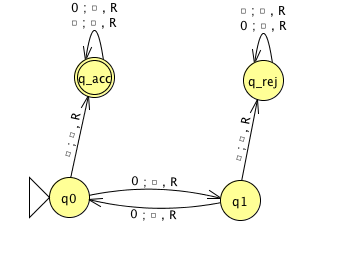
Formal definition:
Sample computation:
| \(q0\downarrow\) | ||||||
|---|---|---|---|---|---|---|
| \(0\) | \(0\) | \(0\) | \(\textvisiblespace\) | \(\textvisiblespace\) | \(\textvisiblespace\) | \(\textvisiblespace\) |
The language recognized by this machine is …
Describing Turing machines (Sipser p. 185) To define a Turing machine, we could give a
Formal definition: the \(7\)-tuple of parameters including set of states, input alphabet, tape alphabet, transition function, start state, accept state, and reject state; or,
Implementation-level definition: English prose that describes the Turing machine head movements relative to contents of tape, and conditions for accepting / rejecting based on those contents.
High-level description: description of algorithm (precise sequence of instructions), without implementation details of machine. As part of this description, can “call" and run another TM as a subroutine.
Fix \(\Sigma = \{0,1\}\), \(\Gamma = \{ 0, 1, \textvisiblespace\}\) for the Turing machines with the following state diagrams:
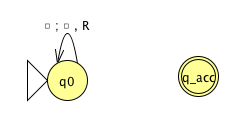
Example of string accepted:
Example of string rejected:
Implementation-level description
High-level description
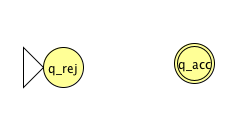
Example of string accepted:
Example of string rejected:
Implementation-level description
High-level description
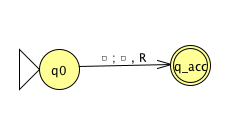
Example of string accepted:
Example of string rejected:
Implementation-level description
High-level description
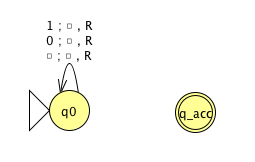
Example of string accepted:
Example of string rejected:
Implementation-level description
High-level description
Sipser Figure 3.10
Conventions in state diagram of TM: \(b \to R\) label means \(b \to b, R\) and all arrows missing from diagram represent transitions with output \((q_{reject}, \textvisiblespace , R)\)
2

Implementation level description of this machine:
Zig-zag across tape to corresponding positions on either side of \(\#\) to check whether the characters in these positions agree. If they do not, or if there is no \(\#\), reject. If they do, cross them off.
Once all symbols to the left of the \(\#\) are crossed off, check for any un-crossed-off symbols to the right of \(\#\); if there are any, reject; if there aren’t, accept.
The language recognized by this machine is \[\{ w \# w \mid w \in \{0,1\}^* \}\]
Computation on input string \(01\#01\)
| \(q_1 \downarrow\) | ||||||
|---|---|---|---|---|---|---|
| \(0\) | \(1\) | \(\#\) | \(0\) | \(1\) | \(\textvisiblespace\) | \(\textvisiblespace\) |
2 High-level description of this machine is
Recall: High-level descriptions of Turing machine algorithms are written as indented text within quotation marks. Stages of the algorithm are typically numbered consecutively. The first line specifies the input to the machine, which must be a string.
Extra practice
Computation on input string \(01\#1\)
| \(q_1\downarrow\) | ||||||
|---|---|---|---|---|---|---|
| \(0\) | \(1\) | \(\#\) | \(1\) | \(\textvisiblespace\) | \(\textvisiblespace\) | \(\textvisiblespace\) |
A language \(L\) is recognized by a Turing machine \(M\) means
A Turing machine \(M\) recognizes a language \(L\) means
A Turing machine \(M\) is a decider means
A language \(L\) is decided by a Turing machine \(M\) means
A Turing machine \(M\) decides a language \(L\) means
Fix \(\Sigma = \{0,1\}\), \(\Gamma = \{ 0, 1, \textvisiblespace\}\) for the Turing machines with the following state diagrams:
 |
 |
| Decider? Yes / No | Decider? Yes / No |
 |
 |
| Decider? Yes / No | Decider? Yes / No |
A Turing-recognizable language is a set of strings that is the language recognized by some Turing machine. We also say that such languages are recognizable.
A Turing-decidable language is a set of strings that is the language recognized by some decider. We also say that such languages are decidable.
An unrecognizable language is a language that is not Turing-recognizable.
An undecidable language is a language that is not Turing-decidable.
True or False: Any decidable language is also recognizable.
True or False: Any recognizable language is also decidable.
True or False: Any undecidable language is also unrecognizable.
True or False: Any unrecognizable language is also undecidable.
True or False: The class of Turing-decidable languages is closed under complementation.
Using formal definition:
Using high-level description:
Church-Turing Thesis (Sipser p. 183): The informal notion of algorithm is formalized completely and correctly by the formal definition of a Turing machine. In other words: all reasonably expressive models of computation are equally expressive with the standard Turing machine.
Definition: A language \(L\) over an alphabet \(\Sigma\) is called co-recognizable if its complement, defined as \(\Sigma^* \setminus L = \{ x \in \Sigma^* \mid x \notin L \}\), is Turing-recognizable.
Theorem (Sipser Theorem 4.22): A language is Turing-decidable if and only if both it and its complement are Turing-recognizable.
Proof, first direction: Suppose language \(L\) is Turing-decidable. WTS that both it and its complement are Turing-recognizable.
Proof, second direction: Suppose language \(L\) is Turing-recognizable, and so is its complement. WTS that \(L\) is Turing-decidable.
Notation: The complement of a set \(X\) is denoted with a superscript \(c\), \(X^c\), or an overline, \(\overline{X}\).
Claim: If two languages (over a fixed alphabet \(\Sigma\)) are Turing-decidable, then their union is as well.
Proof:
Claim: If two languages (over a fixed alphabet \(\Sigma\)) are Turing-recognizable, then their union is as well.
Proof:
Warmup: Design a DFA (deterministic finite automaton) and an NFA (nondeterministic finite automaton) that each recognize each of the following languages over \(\{a,b\}\) \[\{ w \mid \text{$w$ has an $a$ and ends in $b$}\}\]
\[\{ w \mid \text{$w$ has an $a$ or ends in $b$}\}\]
Strategy: To design DFA or NFA for a given language, identify patterns that can be built up as we process strings and create states for intermediate stages. Or: decompose the language to a simpler one that we already know how to recognize with a DFA or NFA.
Recall (from Wednesday of last week, and in textbook Exercise 1.14): if there is a DFA \(M\) such that \(L(M) = A\) then there is another DFA, let’s call it \(M'\), such that \(L(M') = \overline{A}\), the complement of \(A\), defined as \(\{ w \in \Sigma^* \mid w \notin A \}\).
Let’s practice defining automata constructions by coming up with other ways to get new automata from old.
Suppose \(A_1, A_2\) are languages over an alphabet \(\Sigma\). Claim: if there is a NFA \(N_1\) such that \(L(N_1) = A_1\) and NFA \(N_2\) such that \(L(N_2) = A_2\), then there is another NFA, let’s call it \(N\), such that \(L(N) = A_1 \cup A_2\).
Proof idea: Use nondeterminism to choose which of \(N_1\), \(N_2\) to run.
Formal construction: Let \(N_1 = (Q_1, \Sigma, \delta_1, q_1, F_1)\) and \(N_2 = (Q_2, \Sigma, \delta_2,q_2, F_2)\) and assume \(Q_1 \cap Q_2 = \emptyset\) and that \(q_0 \notin Q_1 \cup Q_2\). Construct \(N = (Q, \Sigma, \delta, q_0, F_1 \cup F_2)\) where
\(Q =\)
\(\delta: Q \times \Sigma_\varepsilon \to \mathcal{P}(Q)\) is defined by, for \(q \in Q\) and \(x \in \Sigma_{\varepsilon}\): \[\phantom{\delta((q,x))=\begin{cases} \delta_1 ((q,x)) &\qquad\text{if } q\in Q_1 \\ \delta_2 ((q,x)) &\qquad\text{if } q\in Q_2 \\ \{q1,q2\} &\qquad\text{if } q = q_0, x = \varepsilon \\ \emptyset\text{if } q= q_0, x \neq \varepsilon \end{cases}}\]
Proof of correctness would prove that \(L(N) = A_1 \cup A_2\) by considering an arbitrary string accepted by \(N\), tracing an accepting computation of \(N\) on it, and using that trace to prove the string is in at least one of \(A_1\), \(A_2\); then, taking an arbitrary string in \(A_1 \cup A_2\) and proving that it is accepted by \(N\). Details left for extra practice.
Example: The language recognized by the NFA over \(\{a,b\}\) with state diagram
is:
Could we do the same construction with DFA?
Happily, though, an analogous claim is true!
Suppose \(A_1, A_2\) are languages over an alphabet \(\Sigma\). Claim: if there is a DFA \(M_1\) such that \(L(M_1) = A_1\) and DFA \(M_2\) such that \(L(M_2) = A_2\), then there is another DFA, let’s call it \(M\), such that \(L(M) = A_1 \cup A_2\). Theorem 1.25 in Sipser, page 45
Proof idea:
Formal construction:
Example: When \(A_1 = \{w \mid w~\text{has an $a$ and ends in $b$} \}\) and \(A_2 = \{ w \mid w~\text{is of even length} \}\).
Suppose \(A_1, A_2\) are languages over an alphabet \(\Sigma\). Claim: if there is a DFA \(M_1\) such that \(L(M_1) = A_1\) and DFA \(M_2\) such that \(L(M_2) = A_2\), then there is another DFA, let’s call it \(M\), such that \(L(M) = A_1 \cap A_2\). Sipser Theorem 1.25, page 45
Proof idea:
Formal construction:
So far we have that:
If there is a DFA recognizing a language, there is a DFA recognizing its complement.
If there are NFA recognizing two languages, there is a NFA recognizing their union.
If there are DFA recognizing two languages, there is a DFA recognizing their union.
If there are DFA recognizing two languages, there is a DFA recognizing their intersection.
Our goals for today are (1) prove similar results about other set operations, (2) prove that NFA and DFA are equally expressive, and therefore (3) define an important class of languages.
Suppose \(A_1, A_2\) are languages over an alphabet \(\Sigma\). Claim: if there is a NFA \(N_1\) such that \(L(N_1) = A_1\) and NFA \(N_2\) such that \(L(N_2) = A_2\), then there is another NFA, let’s call it \(N\), such that \(L(N) = A_1 \circ A_2\).
Proof idea: Allow computation to move between \(N_1\) and \(N_2\) “spontaneously" when reach an accepting state of \(N_1\), guessing that we’ve reached the point where the two parts of the string in the set-wise concatenation are glued together.
Formal construction: Let \(N_1 = (Q_1, \Sigma, \delta_1, q_1, F_1)\) and \(N_2 = (Q_2, \Sigma, \delta_2,q_2, F_2)\) and assume \(Q_1 \cap Q_2 = \emptyset\). Construct \(N = (Q, \Sigma, \delta, q_0, F)\) where
\(Q =\)
\(q_0 =\)
\(F =\)
\(\delta: Q \times \Sigma_\varepsilon \to \mathcal{P}(Q)\) is defined by, for \(q \in Q\) and \(a \in \Sigma_{\varepsilon}\): \[\delta((q,a))=\begin{cases} \delta_1 ((q,a)) &\qquad\text{if } q\in Q_1 \textrm{ and } q \notin F_1\\ \delta_1 ((q,a)) &\qquad\text{if } q\in F_1 \textrm{ and } a \in \Sigma\\ \delta_1 ((q,a)) \cup \{q_2\} &\qquad\text{if } q\in F_1 \textrm{ and } a = \varepsilon\\ \delta_2 ((q,a)) &\qquad\text{if } q\in Q_2 \end{cases}\]
Proof of correctness would prove that \(L(N) = A_1 \circ A_2\) by considering an arbitrary string accepted by \(N\), tracing an accepting computation of \(N\) on it, and using that trace to prove the string can be written as the result of concatenating two strings, the first in \(A_1\) and the second in \(A_2\); then, taking an arbitrary string in \(A_1 \circ A_2\) and proving that it is accepted by \(N\). Details left for extra practice.
Suppose \(A\) is a language over an alphabet \(\Sigma\). Claim: if there is a NFA \(N\) such that \(L(N) = A\), then there is another NFA, let’s call it \(N'\), such that \(L(N') = A^*\).
Proof idea: Add a fresh start state, which is an accept state. Add spontaneous moves from each (old) accept state to the old start state.
Formal construction: Let \(N = (Q, \Sigma, \delta, q_1, F)\) and assume \(q_0 \notin Q\). Construct \(N' = (Q', \Sigma, \delta', q_0, F')\) where
\(Q' = Q \cup \{q_0\}\)
\(F' = F \cup \{q_0\}\)
\(\delta': Q' \times \Sigma_\varepsilon \to \mathcal{P}(Q')\) is defined by, for \(q \in Q'\) and \(a \in \Sigma_{\varepsilon}\): \[\delta'((q,a))=\begin{cases} \delta ((q,a)) &\qquad\text{if } q\in Q \textrm{ and } q \notin F\\ \delta ((q,a)) &\qquad\text{if } q\in F \textrm{ and } a \in \Sigma\\ \delta ((q,a)) \cup \{q_1\} &\qquad\text{if } q\in F \textrm{ and } a = \varepsilon\\ \{q_1\} &\qquad\text{if } q = q_0 \textrm{ and } a = \varepsilon \\ \emptyset &\qquad\text{if } q = q_0 \textrm { and } a \in \Sigma \end{cases}\]
Proof of correctness would prove that \(L(N') = A^*\) by considering an arbitrary string accepted by \(N'\), tracing an accepting computation of \(N'\) on it, and using that trace to prove the string can be written as the result of concatenating some number of strings, each of which is in \(A\); then, taking an arbitrary string in \(A^*\) and proving that it is accepted by \(N'\). Details left for extra practice.
Application: A state diagram for a NFA over \(\Sigma = \{a,b\}\) that recognizes \(L (( a^*b)^* )\):
Suppose \(A\) is a language over an alphabet \(\Sigma\). Claim: if there is a NFA \(N\) such that \(L(N) = A\) then there is a DFA \(M\) such that \(L(M) = A\).
Proof idea: States in \(M\) are “macro-states" – collections of states from \(N\) – that represent the set of possible states a computation of \(N\) might be in.
Formal construction: Let \(N = (Q, \Sigma, \delta, q_0, F)\). Define \[M = (~ \mathcal{P}(Q), \Sigma, \delta', q', \{ X \subseteq Q \mid X \cap F \neq \emptyset \}~ )\] where \(q' = \{ q \in Q \mid \text{$q = q_0$ or is accessible from $q_0$ by spontaneous moves in $N$} \}\) and \[\delta' (~(X, x)~) = \{ q \in Q \mid q \in \delta( ~(r,x)~) ~\text{for some $r \in X$ or is accessible from such an $r$ by spontaneous moves in $N$} \}\]
Consider the state diagram of an NFA over \(\{a,b\}\). Use the “macro-state” construction to find an equivalent DFA.

Consider the state diagram of an NFA over \(\{0,1\}\). Use the “macro-state” construction to find an equivalent DFA.

Note: We can often prune the DFAs that result from the “macro-state” constructions to get an equivalent DFA with fewer states (e.g. only the “macro-states" reachable from the start state).
The class of regular languages
Fix an alphabet \(\Sigma\). For each language \(L\) over \(\Sigma\):
| There is a DFA over \(\Sigma\) that recognizes \(L\) | \(\exists M ~(M \textrm{ is a DFA and } L(M) = A)\) |
| if and only if | |
| There is a NFA over \(\Sigma\) that recognizes \(L\) | \(\exists N ~(N \textrm{ is a NFA and } L(N) = A)\) |
| if and only if | |
| There is a regular expression over \(\Sigma\) that describes \(L\) | \(\exists R ~(R \textrm{ is a regular expression and } L(R) = A)\) |
A language is called regular when any (hence all) of the above three conditions are met.
We already proved that DFAs and NFAs are equally expressive. It remains to prove that regular expressions are too.
Part 1: Suppose \(A\) is a language over an alphabet \(\Sigma\). If there is a regular expression \(R\) such that \(L(R) = A\), then there is a NFA, let’s call it \(N\), such that \(L(N) = A\).
Structural induction: Regular expression is built from basis regular expressions using inductive steps (union, concatenation, Kleene star symbols). Use constructions to mirror these in NFAs.
Application: A state diagram for a NFA over \(\{a,b\}\) that recognizes \(L(a^* (ab)^*)\):
Part 2: Suppose \(A\) is a language over an alphabet \(\Sigma\). If there is a DFA \(M\) such that \(L(M) = A\), then there is a regular expression, let’s call it \(R\), such that \(L(R) = A\).
Proof idea: Trace all possible paths from start state to accept state. Express labels of these paths as regular expressions, and union them all.
Add new start state with \(\varepsilon\) arrow to old start state.
Add new accept state with \(\varepsilon\) arrow from old accept states. Make old accept states non-accept.
Remove one (of the old) states at a time: modify regular expressions on arrows that went through removed state to restore language recognized by machine.
Application: Find a regular expression describing the language recognized by the DFA with state diagram
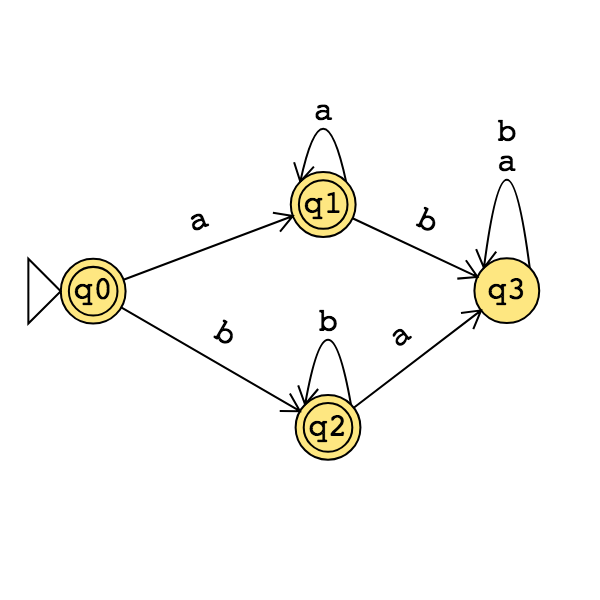
Review: Formal definition of finite automaton: \(M = (Q, \Sigma, \delta, q_0, F)\)
2
Finite set of states \(Q\)
Alphabet \(\Sigma\)
Transition function \(\delta\)
Start state \(q_0\)
Accept (final) states \(F\)
In the state diagram of \(M\), how many outgoing arrows are there from each state?
\(M = ( \{ q, r, s\}, \{a,b\}, \delta, q, \{q\} )\) where \(\delta\) is (rows labelled by states and columns labelled by symbols):
| \(\delta\) | \(a\) | \(b\) |
|---|---|---|
| \(q\) | \(r\) | \(r\) |
| \(r\) | \(s\) | \(s\) |
| \(s\) | \(q\) | \(q\) |
The state diagram for \(M\) is
Give two examples of strings that are accepted by \(M\) and two examples of strings that are rejected by \(M\):
\(L(M) =\)
A regular expression describing \(L(M)\) is
Let the alphabet be \(\Sigma_1 = \{0,1\}\).
A state diagram for a finite automaton that recognizes \(\{w \in \Sigma_1^* \mid w~\text{contains at most two $1$'s} \}\) is
A state diagram for a finite automaton that recognizes \(\{w \in \Sigma_1^* \mid w~\text{contains more than two $1$'s} \}\) is
Strategy: Add “labels" for states in the state diagram, e.g. “have not seen any of desired pattern yet” or “sink state”. Then, we can use the analysis of the roles of the states in the state diagram to work towards a description of the language recognized by the finite automaton.
A useful bit of terminology: the iterated transition function of a finite automaton \(M = (Q, \Sigma, \delta, q_0, F)\) is defined recursively by \[\delta^* (~(q,w)~) =\begin{cases} q \qquad &\text{if $q \in Q, w = \varepsilon$} \\ \delta( ~(q,a)~) \qquad &\text{if $q \in Q$, $w = a \in \Sigma$ } \\ \delta(~(\delta^*(q,u), a) ~) \qquad &\text{if $q \in Q$, $w = ua$ where $u \in \Sigma^*$ and $a \in \Sigma$} \end{cases}\]
Using this terminology, \(M\) accepts a string \(w\) over \(\Sigma\) if and only if \(\delta^*( ~(q_0,w)~) \in F\).
Suppose \(A\) is a language over an alphabet \(\Sigma\). By definition, this means \(A\) is a subset of \(\Sigma^*\). Claim: if there is a DFA \(M\) such that \(L(M) = A\) then there is another DFA, let’s call it \(M'\), such that \(L(M') = \overline{A}\), the complement of \(A\), defined as \(\{ w \in \Sigma^* \mid w \notin A \}\).
Proof idea:
Proof:
Application: Design a finite automaton that recognizes the language of all strings over \(\{a,b\}\) whose length is not a multiple of \(3\).
Note: On Friday, we’ll see a new kind of finite automaton. It will be helpful to distinguish it from the machines we’ve been talking about so we’ll use Deterministic Finite Automaton (DFA) to refer to the machines from Section 1.1.
| Nondeterministic finite automaton (Sipser Page 53) Given as \(M = (Q, \Sigma, \delta, q_0, F)\) | |
| Finite set of states \(Q\) | Can be labelled by any collection of distinct names. Default: \(q0, q1, \ldots\) |
| Alphabet \(\Sigma\) | Each input to the automaton is a string over \(\Sigma\). |
| Arrow labels \(\Sigma_\varepsilon\) | \(\Sigma_\varepsilon = \Sigma \cup \{ \varepsilon\}\). |
| Arrows in the state diagram are labelled either by symbols from \(\Sigma\) or by \(\varepsilon\) | |
| Transition function \(\delta\) | \(\delta: Q \times \Sigma_{\varepsilon} \to \mathcal{P}(Q)\) gives the set of possible next states for a transition |
| from the current state upon reading a symbol or spontaneously moving. | |
| Start state \(q_0\) | Element of \(Q\). Each computation of the machine starts at the start state. |
| Accept (final) states \(F\) | \(F \subseteq Q\). |
| \(M\) accepts the input string \(w \in \Sigma^*\) if and only if there is a computation of \(M\) on \(w\) that processes the whole string and ends in an accept state. | |
The formal definition of the NFA over \(\{0,1\}\) given by this state diagram is:
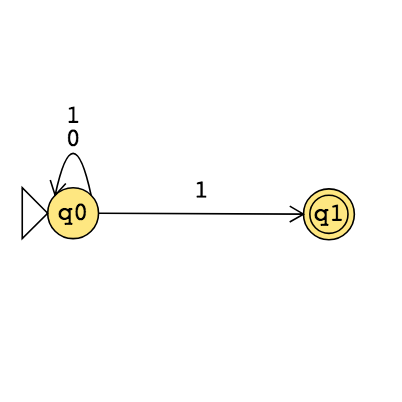
The language over \(\{0,1\}\) recognized by this NFA is:
Change the transition function to get a different NFA which accepts the empty string (and potentially other strings too).
The state diagram of an NFA over \(\{a,b\}\) is below. The formal definition of this NFA is:
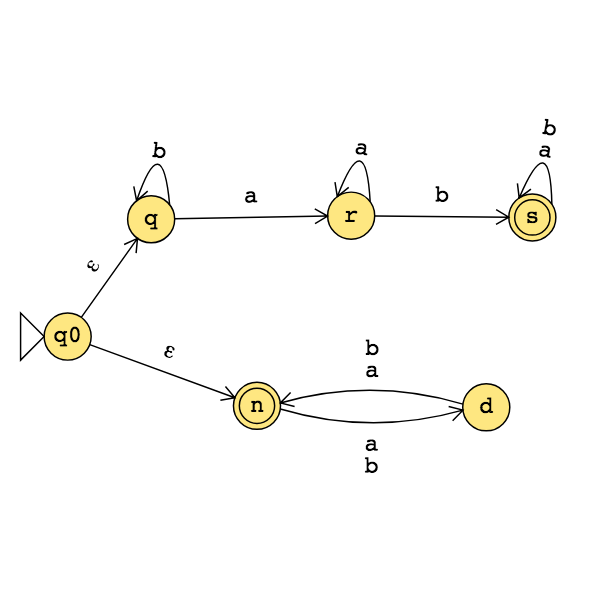
The language recognized by this NFA is:
Review: Determine whether each statement below about regular expressions over the alphabet \(\{a,b,c\}\) is true or false:
True or False: \(ab \in L(~ (a \cup b)^* ~)\)
True or False: \(ba \in L( ~ a^* b^* ~)\)
True or False: \(\varepsilon \in L(a \cup b \cup c)\)
True or False: \(\varepsilon \in L(~ (a \cup b)^* ~)\)
True or False: \(\varepsilon \in L( ~ aa^* \cup bb^* ~)\)
**This definition was in the pre-class reading** A finite automaton (FA) is specified by \(M = (Q, \Sigma, \delta, q_0, F)\). This \(5\)-tuple is called the formal definition of the FA. The FA can also be represented by its state diagram: with nodes for the state, labelled edges specifying the transition function, and decorations on nodes denoting the start and accept states.
Finite set of states \(Q\) can be labelled by any collection of distinct names. Often we use default state labels \(q0, q1, \ldots\)
The alphabet \(\Sigma\) determines the possible inputs to the automaton. Each input to the automaton is a string over \(\Sigma\), and the automaton “processes” the input one symbol (or character) at a time.
The transition function \(\delta\) gives the next state of the automaton based on the current state of the machine and on the next input symbol.
The start state \(q_0\) is an element of \(Q\). Each computation of the machine starts at the start state.
The accept (final) states \(F\) form a subset of the states of the automaton, \(F \subseteq Q\). These states are used to flag if the machine accepts or rejects an input string.
The computation of a machine on an input string is a sequence of states in the machine, starting with the start state, determined by transitions of the machine as it reads successive input symbols.
The finite automaton \(M\) accepts the given input string exactly when the computation of \(M\) on the input string ends in an accept state. \(M\) rejects the given input string exactly when the computation of \(M\) on the input string ends in a nonaccept state, that is, a state that is not in \(F\).
The language of \(M\), \(L(M)\), is defined as the set of all strings that are each accepted by the machine \(M\). Each string that is rejected by \(M\) is not in \(L(M)\). The language of \(M\) is also called the language recognized by \(M\).
What is finite about all finite automata? (Select all that apply)
The size of the machine (number of states, number of arrows)
The length of each computation of the machine
The number of strings that are accepted by the machine

The formal definition of this FA is
Classify each string \(a, aa, ab, ba, bb, \varepsilon\) as accepted by the FA or rejected by the FA.
Why are these the only two options?
The language recognized by this automaton is

The language recognized by this automaton is

The language recognized by this automaton is